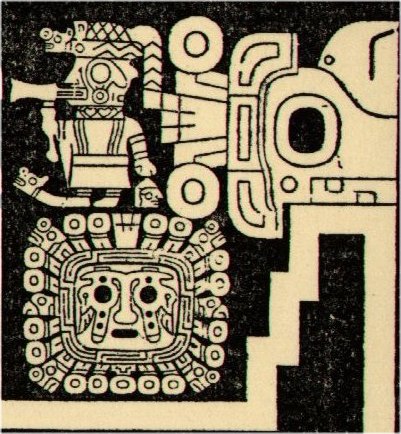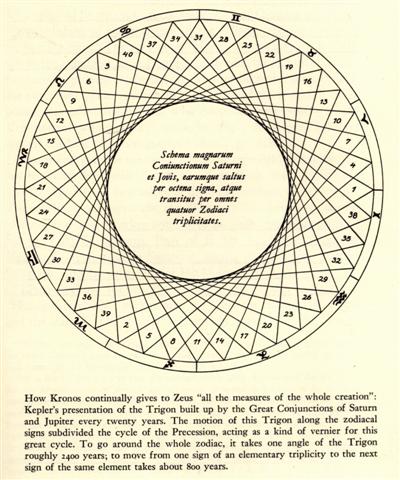|
TRANSLATIONS
There is a carrion bird located at midwinter. "The Latin Cronos was called Saturn and in his statues he was armed with a pruning-knife crooked like a crow's bill: probably a rebus on his name. For though the later Greeks liked to think that the name meant chronos, 'time' because any very old man was humorously called 'Cronos', the more likely derivation is from the same root cron or corn that gives the Greek and Latin words for crow - corone and cornix." (The White Goddess) The sun gate at Tiahuanaco affirms that there is a great bird with a hooked beak at solstice:
"Primitive peoples who are, like all who live close to nature, extremely careful observers, tried to represent hierarchy and its various grades in the same way that they observed it among the animals. They noted the number of hierarchical degrees that existed among the latter and especially among the birds of prey. They observed the great respect and profound veneration showed by the condors to their leader, the 'Mayku' ... an ancient and venerable male condor whose head is adorned with an imposing crest; and this crest is, precisely, the origin of the crown in the ideology of the peoples of the Andes. These primitive peoples also observed that when a larger animal died in the field, no bird of prey, large or small, would dare to touch his already decayed body though it had reached the stage most attractive to them; rather they would wait patiently and at a distance for some days, without satisfying their gluttonous appetites or allaying their great hunger until the 'king condor' arrived. He was called by the natives 'Cunturi Mamani Mayku', a male condor, old and venerable, with his majestic crest-crown and with his plumage almost white with age. They could wait, as the author had occasion to observe a few years ago in the 'apacheta' of Quimza Cruz in the Cordillera Real of Bolivia. After two 'Condores Hilacata' had inspected the ground from a great height, they withdrew until they could see the 'Mayku' come from afar with a majestic gliding flight, to present himself at the hideous feast. After the ceremonious movement which he makes in the direction of the gathering, the 'Mayku' proceeds to devour the eyes, the tongue and the anus of the cadaver. Then, his appetite satisfied, he gives the signal of permission to the condors with a reeling movement of his body so that they, too, may satisfy their hunger ..." (Posnansky) To extinguish a fire is to kill it. Fire is a strange element not like anything else, but it is moving, it is eating and it is even making noices, 'talking'. It is alive. To make a fire is to make life. To extinguish a fire is to kill. Therefore the pruning-knife, possible to use not only to reap but also for other executions, is an adequate symbol for extinguishing fire. "That Cronos the emasculator was deposed by his son Zeus is an economical statement: the Achaean herdsmen who on their arrival in Northern Greece had identified their Sky-god with the local oak-hero gained ascendancy over the Pelasgian agriculturalists. But there was a compromise between the two cults. DionŽ, or Diana, of the woodland was identified with DanaŽ of the barley; and that an inconvenient golden sickle, not a bill-hook of flint or obsidian, was later used by the Gallic Druids for lopping the mistletoe, proves that the oak-ritual had been combined with that of the barley-king whom the Goddess DanaŽ, or Alphito, or Demeter, or Ceres, reaped with her moon-shaped sickle. Reaping meant castration; similarly, the Galla warriors of Abyssinia carry a miniature sickle into battle for castrating their enemies." (The White Goddess) Without any special effort whatsoever my work with trying to understand the rongorongo texts is flowing on synchronously. Parallel with writing here I am documenting the text of Small Wasington (R) and by coincidence the R-text to a large extent happens to be parallel with the A-text (Tahua). While thinking about the great carrion bird I suddenly saw a complex glyph (Rb1-105) which possibly describes the 'pruning':
Aside from the visual impact there is a kind of affirmation in a parallel text (in triplicate) in Q (but not in H and P), which may tell about 3 'pruning times' during the year:
Saturn is effectively telling the time by cutting it to pieces, which reminds us about Marduk dividing the night in half by a slash and Maui cutting Tuna into 9 pieces. Similarly I find in Wilkinson that the Apophis snake is 'killed' by knives:
Wilkinson comments that magic knives were involved in destroying the enemies of the sun at each dawn and that the two sycomore trees between which the sun rises each morning were called the 'two knives'. I believe that initially there were scientific observations determining the role of Saturn (the planet), as described in Hamlet's Mill: "Saturn does give the measures: this is the essential point. How are we to reconcile it with Saturn the First King, the ruler of the Golden Age who is now asleep at the outer confines of the world? The conflict is only apparent, as will be seen. For now it is essential to recognize that, whether one has to do with the Mesopotamian Saturn, Enki / Ea, or with Ptah of Egypt, he is the 'Lord of Measures' - spell it 'me' in Sumerian, 'parshu' in Akkadian, 'maat' in Egyptian. And the same goes for His Majesty, the Yellow Emperor of China - yellow, because the element earth belongs to Saturn - 'Huang-ti established everywhere the order for the sun, the moon and the stars'. The melody remains the same. It might help to understand the general idea, but particularly the lucubrations of Proclus, to have a look at the figure drawn by Kepler, which represents the moving triangle fabricated by 'Great Conjunctions', that is those of Saturn and Jupiter.
One of these points needs roughly 2.400 years to move through the whole zodiac." (Hamlet's Mill) The Trigon (3 corners) is based on the conjunctions every 20 years between Jupiter and Saturn, at which points Saturns gives order(s) to Jupiter (the earthly ruler). To move from one zodiacal sign to the next takes about 800 years. These important numbers occur everywhere in myth and calendars: 3, 8, 20 and 24. Probably the 3 wives of the sun reflect the Trigon. The '-gon' in Trigon has the same meaning as the 'gen-' in generation. The Sycomore Lady surely must be the Trigon. Maybe even the 3 glyphs of the X-area in A reflect the Trigon. I guess that Saturday is 'equivalent' with the X area. We there find the dark sign poporo (GD21) with 4 'pods' (presumably to indicate the 4 weeks in a month and the 4 seasons of the year) and a 5th special one at the base (fullmoon and winter solstice):
The 6 first days of the week correspond to the 6 double-months in a year and the 7th day to the X-area. Maybe the running person with 2 fishes illustrates that time is running, the gap between the fishes being the gap in time between two periods (weeks/years). The arm is Y-shaped and the leg ends in fiery toes, possibly meaning that the top fish is 'dead' while the bottom one is new and alive. Ikaika was the name of Jupiter in Hawaii, and Makemson somewhere in her book says: 'In modern times much confusion prevails regarding the identification of the ancient names with individual planets.' I don't think the Hawaiians made any mistake - Ikaika was probably to indicate the conjunction of Jupiter and Saturn, double 'fishes'. |
||||||||||||||||||||||||||||||||||||||||||||||||
























